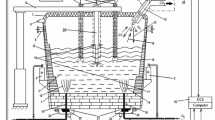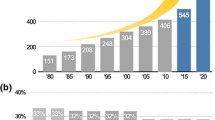Features are established for formation of flux-cored wire spatial movement trajectories in relation to its parameters and rate of introduction, and possible areas of filler release are identified. A procedure is developed and a nomogram is constructed for evaluating existing technologies of steel treatment with flux-cored wire containing calcium reagents, and reasons for a reduction in calcium release are sought, making it possible to optimize flux-cored wire introduction rate in order to increase the efficiency, resource and ecological indices of the process.


Similar content being viewed by others
References
D. A. Dyudkin and V. V. Kisilenko, Steel Production, Vol. 3, Steel Extra-Furnace Treatment [in Russian], Teplotekhnik, Moscow (2010).
D. A. Dyukin (ed.), Extra-Furnace Melt Treatment with Flux-Cored Wire [in Russian], Yugo-Vostok, Donetsk (2002).
G. Knyupel, Steel Deoxidation and Vacuum Treatment. Ladle Metallurgy Bases and Technology [in Russian], Metallurgiya, Moscow (1984).
V. Yu. Bolotov and S. E. Samokhvalov, “Combined task of movement, melting, and assimilation of wire with blowing metal in a steel-pouring ladle,” Proc. Dneprodzerzh. State Techn. Univ. (1998), pp. 39–44.
N. A. Smirnov and V. A. Kudrin, Steel Refining with Blowing Powders into a Furnace and Ladle [in Russian], Metallurgiya, Moscow (1984).
D. A. Dyudkin,V. V. Parenchuk,and A. Ya. Babanin,“Dynamics of flux-cored wire (tape) dissolution in molten steel,” Met. Gorn. Prom., No. 1, 24–25 (2006).
V. A. Vikhlevshchuk, V. Yu. Bolotov, I. A. Pavlyuchenko, et al., “Mathematical modelling of three-dimensional problem of aluminum and flux-cored wire movement taking of their melting and blending with metal bottom blowing with argon,” Teor. Prakt. Met., No. 3, 46–50 (2000).
G. A. Anisovich, V. I. Timoshpelskii, V. Yu. Bolotov, et al., Theoretical Basis of Melting Flux-Cored Wire Materials During Ladle Metallurgy [in Russian], Vysshaya Shkola, Minsk (2002).
V. V. Belousov, V. D. Aleksandro, A. Ya. Babanin, et al., “Mass transfer during steel treatment in steel-pouring ladle with flux-cored wire containing calcium reagents,” Metallurg, No. 3, 17–21 (2010).
E. G. Turdogam, “Metallurgical study of calcium assimilation by molten and solidifying steel,” Treatment of Steel with Calcium: Coll., Proc. Int. Symp. on Steel Treatment with Calcium, Glasgow, June 30, 1988, Panov IES, Kiev (1989), pp. 19–41.
A. Ya. Babanin, B. F. Belov, and V. A. Aksenenko, “Reaction of gas bubbles of chemically active elements with molten steel,” Proc. 9th Congr. on Steel Smelters, Staryi Oskol, Sept. 17–19, 2006, Moscow (2007), pp. 543–552.
Author information
Authors and Affiliations
Corresponding author
Additional information
Translated from Metallurg, No. 12, pp. 58–62, December, 2012.
Rights and permissions
About this article
Cite this article
Belousov, V.V., Babanin, A.Y., Beskrovnaya, M.V. et al. Improvement in Efficiency, Resource and Ecological Indices for Extra-Furnace Steel Treatment with Flux-Cored Wire Containing Calcium Reagents. Metallurgist 56, 933–937 (2013). https://doi.org/10.1007/s11015-013-9677-1
Received:
Published:
Issue Date:
DOI: https://doi.org/10.1007/s11015-013-9677-1




